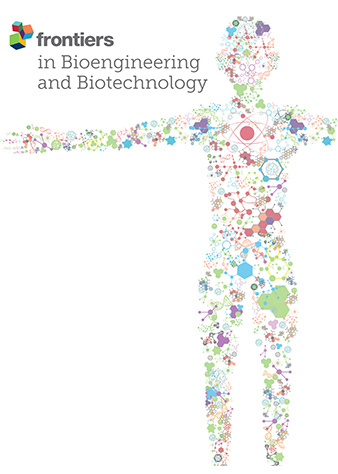Biomechanical effects of endplate sagittal coverage change on cervical disc replacement: a finite element analysis
IF 4.3
3区 工程技术
Q1 BIOTECHNOLOGY & APPLIED MICROBIOLOGY
引用次数: 0
Abstract
BackgroundIn recent years, the number of artificial cervical disc replacements has increased, and paravertebral ectopic ossification is a common complication. Although the exact mechanism is not clear, some studies suggest that it is related to the concentration of tissue stress caused by incomplete coverage of the trailing edge of the endplate. Therefore, this study performed a quantitative analysis to compare the biomechanical effects of different sagittal distances at the posterior edge of the endplate of the upper and lower prosthesis on the cervical spine and to explore the mechanical response of incomplete coverage of the posterior edge of the endplate on the paravertebral tissues.MethodsA C2-C7 nonlinear finite element model of the cervical spine was established and validated. Based on the cervical spine model, cervical disc replacement surgery models were constructed with different distances of sagittal distance at the posterior edge of the upper prosthetic endplate (0, 1, 2, 3 mm, respectively) and sagittal distance at the posterior edge of the lower prosthetic endplate (1, 2, 3 mm, respectively). Each model was subjected to the same 1Nm torque and 73.6N driven compressive load. Range of motion (ROM), intervertebral disc pressure (IDP), facet joint force (FJF), and endplate stress were measured at the cervical surgical and other segments.ResultsCompared to the intact cervical spine model, the sagittal distance of the posterior edge of the prosthesis endplate at different distances increased the stress on the intervertebral disc and the capsular joint in the adjacent vertebral body segments to different degrees, especially in extension. In different directions of motion, the posterior margin sagittal distance of the posterior edge of the endplate of the lower prosthesis has a greater mechanical influence on the cervical spine compared to the posterior margin sagittal distance of the posterior edge of the endplate of the upper prosthesis. Compared with the intact model, the biomechanical parameters (ROM, FJF, endplate stress) of the C5-C6 segment increased the most when the sagittal distance of the posterior edge of the endplate of the upper prosthesis was 3 mm. Compared with the intact model, the maximum intervertebral disc stress of C4-C5 and C6-C7 was 0.57 MPa and 0.53 MPa, respectively, when the sagittal distance of the posterior edge of the upper prosthetic endplate was 3 mm.ConclusionAfter the sagittal distance of the posterior edge of the prosthetic endplate was completely covered, the mechanical influence of the entire cervical spine was low. The sagittal distance at the posterior edge of the endplate of different sizes changed the motion pattern and load distribution of the implanted segment to some extent. When the sagittal distance between the prosthesis and the upper endplate was greater than or equal to 3 mm, the mechanical indices of the implanted segment increased significantly, increasing the risk of local tissue injury, especially during extension motion. Compared to the sagittal distance at the posterior edge of the endplate of the lower prosthesis, increasing the sagittal distance at the posterior edge of the endplate of the upper prosthesis has a greater effect on the mechanics of the cervical spine.终板矢状面覆盖变化对颈椎间盘置换术的生物力学影响:有限元分析
背景近年来,人工颈椎间盘置换术的数量不断增加,而椎旁异位骨化是一种常见的并发症。虽然确切的机制尚不清楚,但一些研究认为这与终板后缘覆盖不完全导致的组织应力集中有关。因此,本研究进行了定量分析,比较了上下假体终板后缘不同矢状距对颈椎的生物力学影响,并探讨了终板后缘覆盖不完全对椎旁组织的力学反应。在该颈椎模型的基础上,建立了上人工椎间盘后缘矢状距不同(分别为 0、1、2、3 毫米)和下人工椎间盘后缘矢状距不同(分别为 1、2、3 毫米)的颈椎间盘置换手术模型。每个模型均承受相同的 1Nm 扭矩和 73.6N 的驱动压缩负荷。结果与完整的颈椎模型相比,假体终板后缘不同距离的矢状距离在不同程度上增加了相邻椎体节段的椎间盘和关节囊的应力,尤其是在伸展时。在不同的运动方向上,与上部假体终板后缘矢状距相比,下部假体终板后缘矢状距对颈椎的力学影响更大。与完整模型相比,当上假体终板后缘矢状距为 3 mm 时,C5-C6 节段的生物力学参数(ROM、FJF、终板应力)增加最多。与完整模型相比,当上假体终板后缘的矢状距离为 3 mm 时,C4-C5 和 C6-C7 的最大椎间盘应力分别为 0.57 MPa 和 0.53 MPa。不同大小的假体终板后缘矢状距在一定程度上改变了植入节段的运动模式和负荷分布。当假体与上椎体终板之间的矢状距离大于或等于3毫米时,植入节段的机械指数显著增加,增加了局部组织损伤的风险,尤其是在伸展运动时。与下部假体终板后缘的矢状距离相比,增加上部假体终板后缘的矢状距离对颈椎力学的影响更大。
本文章由计算机程序翻译,如有差异,请以英文原文为准。
求助全文
约1分钟内获得全文
求助全文
来源期刊

Frontiers in Bioengineering and Biotechnology
Chemical Engineering-Bioengineering
CiteScore
8.30
自引率
5.30%
发文量
2270
审稿时长
12 weeks
期刊介绍:
The translation of new discoveries in medicine to clinical routine has never been easy. During the second half of the last century, thanks to the progress in chemistry, biochemistry and pharmacology, we have seen the development and the application of a large number of drugs and devices aimed at the treatment of symptoms, blocking unwanted pathways and, in the case of infectious diseases, fighting the micro-organisms responsible. However, we are facing, today, a dramatic change in the therapeutic approach to pathologies and diseases. Indeed, the challenge of the present and the next decade is to fully restore the physiological status of the diseased organism and to completely regenerate tissue and organs when they are so seriously affected that treatments cannot be limited to the repression of symptoms or to the repair of damage. This is being made possible thanks to the major developments made in basic cell and molecular biology, including stem cell science, growth factor delivery, gene isolation and transfection, the advances in bioengineering and nanotechnology, including development of new biomaterials, biofabrication technologies and use of bioreactors, and the big improvements in diagnostic tools and imaging of cells, tissues and organs.
In today`s world, an enhancement of communication between multidisciplinary experts, together with the promotion of joint projects and close collaborations among scientists, engineers, industry people, regulatory agencies and physicians are absolute requirements for the success of any attempt to develop and clinically apply a new biological therapy or an innovative device involving the collective use of biomaterials, cells and/or bioactive molecules. “Frontiers in Bioengineering and Biotechnology” aspires to be a forum for all people involved in the process by bridging the gap too often existing between a discovery in the basic sciences and its clinical application.
 求助内容:
求助内容: 应助结果提醒方式:
应助结果提醒方式:


